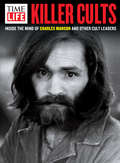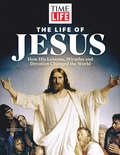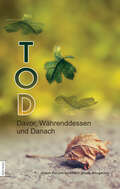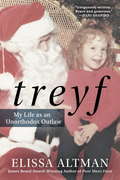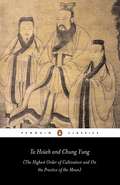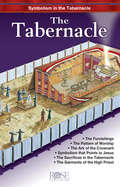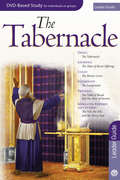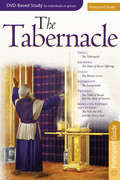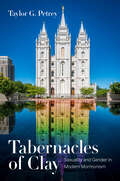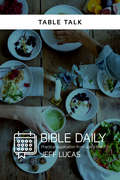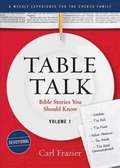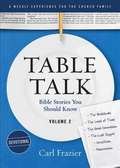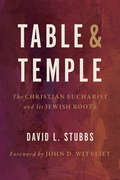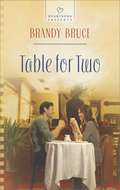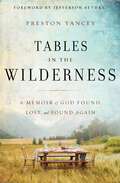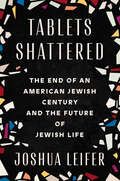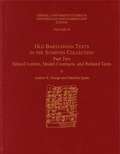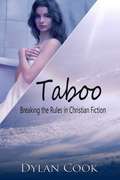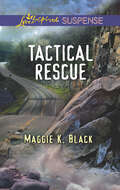- Table View
- List View
TIME-LIFE Killer Cults: Inside the Mind of Charles Manson and Other Cult Leaders
by The Editors of TIME-LIFEKiller cults horrify us-and fascinate us. Their leaders demand obedience from their followers, even when the ends are deadly. Manson is perhaps the most notorious, but history is filled with brutal cult leaders: Jim Jones, David Koresh, Marshall Applewhite, Shoko Asahara. How do these men take hold of so many lives?
TIME-LIFE The Life of Jesus: How His Lessons, Miracles and Devotion Changed the World
by The Editors of TIME-LIFEFrom his early years, his teachings and miracles, to his death, burial, and resurrection, TIME-LIFE explores the life of Jesus.
TOD Davor, Währenddessen und Danach
by Dada BhagwanIn dem Buch "Tod - Davor, Währenddessen und Danach" spricht Param Pujya Dada Bhagwan uralte, unbeantwortete Fragen zu Tod und Sterben an. Param Pujya Dadashri bietet tiefgründige Antworten auf Fragen wie: "Was ist der Tod?". "Was sind die Stadien des Sterbens und die Zeichen des Todes?". "Was passiert, wenn du stirbst?". "Gibt es ein Leben nach dem Tod und kannst du einen Beweis für das Leben nach dem Tod erbringen?". "Bitte erkläre Reinkarnation und beschreibe die Reise der Seele?". Er bietet auch Lösungen für gemeinsame Anliegen wie: "Wie kann die Angst vor dem Sterben aufgelöst werden? Wie kann ich meiner Angst vor dem Tod begegnen?". "Wie kann man mit Stress umgehen und wie man Trauer und Verlust bewältigt, nachdem man einen geliebten Menschen verloren hat?". Mein Tod steht bevor, bitte sage mir, wie ich spiritueller werden kann?". In dieser unschätzbaren Quelle stellt Param Pujya Dadashri den Tod in einen größeren spirituellen Kontext, indem er beschreibt, wie man das Selbst erlangt. Er erklärt, dass das Wissen über das Selbst die Spiritualität ist, die von all dem Leid befreit, das mit Tod und Sterben zusammenhängt.
TOUCH
by Pastor Rudy RasmusBefore God touched his heart and transformed his life, Rudy Rasmus was a businessman running a "borderline bordello" in Houston. But thousands now know him simply as "Pastor Rudy"-with a downtown ministry at St. John's Church that he and his wife Juanita started to reach out to those who Jesus called "the least of these." TOUCH is the amazing story of Rudy's life and ministry of grace that is changing lives daily. The church has become one of the most culturally diverse congregations in the country with people from every social and economic background, including the homeless, sharing the same pew. Pastor Rudy's message to touch the lives of those in our own communities has a lesson for us all. Pastor Rudy is also a featured contributor to O, The Oprah Magazine-answering questions on ethics and marking one of the few times O has asked a Pastor to serve in this manner.
TREYF: My Life as an Unorthodox Outlaw
by Elissa AltmanFrom the Washington Post columnist and James Beard Award-winning author of Poor Man's Feast comes a story of seeking truth, acceptance, and self in a world of contradiction... Treyf: According to Leviticus, unkosher and prohibited, like lobster, shrimp, pork, fish without scales, the mixing of meat and dairy. Also, imperfect, intolerable, offensive, undesirable, unclean, improper, broken, forbidden, illicit. Fans of Augusten Burroughs and Jo Ann Beard will enjoy this kaleidoscopic, universal memoir in which Elissa Altman explores the tradition, religion, family expectations, and the forbidden that were the fixed points in her Queens, New York, childhood. Every part of Altman's youth was laced with contradiction and hope, betrayal and the yearning for acceptance: synagogue on Saturday and Chinese pork ribs on Sunday; bat mitzvahs followed by shrimp-in-lobster-sauce luncheons; her old-country grandparents, whose kindness and love were tied to unspoken rage, and her bell-bottomed neighbors, whose adoring affection hid dark secrets. While the suburban promise of The Brady Bunch blared on television, Altman searched for peace and meaning in a world teeming with faith, violence, sex, and paradox. Spanning from 1940s wartime Brooklyn to 1970s Queens to present-day rural New England, Treyf captures the collision of youthful cravings and grown-up identities. It is a vivid tale of what it means to come to yourself both in spite and in honor to your past.From the Hardcover edition.
Ta Hsüeh and Chung Yung: The Highest Order of Cultivation and On the Practice of the Mean
by Andrew PlaksSet alongside The Analects and Mencius, these two texts make up the 'Four Books' of Chinese Confucian tradition. Their depiction of the 'Way of Great Learning' focuses on the moral tenets of Confucian thinking, establishing a universal framework that links individuals with the cosmos. By drawing together key ethical and philophical, and metaphysical issues, the essays deal with the individual's development of moral character. They have long occupied a central position in the educational and political infrastructure of China, Korea and Japan, and their influence and popularity continues to grow, in the East and in the West.
Tabernacle
by Rose Publishing"The best selling The Tabernacle ebook brings to life the Old Testament teaching on the Tabernacle in the Wilderness of Sinai, the place where God promised to dwell among his people. The full-color ebook features a cutaway illustration that provides an inside look at the Tabernacle. The artist's illustration indicates more than 15 important features of the Tabernacle, such as the Ark of the Covenant, the High Priest, and the Sacrifice, and how they relate to our relationship with God today through Christ. Compared to textbooks on the Tabernacle, The Tabernacle ebook is designed and written to be easy-to-understand and may be used for personal study or by a wide variety of groups. The Tabernacle is a tremendous teaching aid and an informative guide to teach on topics such as: *What it was like to enter the Tabernacle *The Pattern of Worship and the furnishings of the Tabernacle *How the 12 Tribes of Israel camped around the Tabernacle in a specific order *The Ark of the Covenant *Old Testament Symbols of Jesus *Aaron as High Priest and Jesus as the better High Priest The Tabernacle pamphlet illustration, created exclusively for Rose Publishing by renowned Bible artist Stan Stein, provides an amazing inside look at the Tabernacle and all its furnishings. But this visual teaching aid not only explains the Old Testament Tabernacle in detail, it also helps young and old alike understand the symbolic relationship between the Tabernacle and Jesus Christ. The content of The Tabernacle offers a wealth of information for the study leader and those they teach, including: 1. A Numbered Key to the full-color Tabernacle illustration includes Bible references and descriptions for each of the following Tabernacle features *The Gate of the Court *Court Fence *Brazen Altar *Offerings *Laver of Bronze *Tabernacle *Holy Place *Golden Lampstand *Table of Showbread (Shewbread) *Altar of Incense *Veil *Most Holy Place (Holy of Holies) *Ark of the Covenant *Mercy Seat *The Cloud and Pillar of Fire *The High Priest and His Holy Garments2. An In-Depth Description of the Ark of the Covenant *A physical description of the Ark *Its purpose *Where it was placed in the Tabernacle *The role of the Levites, the Day of Atonement and the Mercy Seat *Where God dwelled and spoke to the Priest *The scriptural references to the Ark of the Covenant3. Old Testament Symbols of Jesus, including Old Testament and New Testament Bible references. 4. A Description and full-color illustration of the High Priest *Qualifications *Clothing and the purpose of the 11 specific items found in scriptures, such as the Turban (or Mitre), onyx stones on shoulders, and breastplate with 12 precious stones *Service of the High Priest *Aaron, the High Priest *Jesus, the better High Priest5. The Types of Sacrifices in the Tabernacle, their purposes and scripture reference 6. The Journey of the Ark of the Covenant *From Mt. Sinai and covering 400 years beginning with the Exodus in 1450 BC *Ending in 500 BC when Jeremiah prophesied that the Ark would be replaced by the Lord's presence.7. The Tabernacle campsite and the placement of the 12 Tribes of Israel around the Tabernacle, including: *The families of Merari and the Tribes of Naphtali, Asher, Dan *The families Moses, Aaron and sons and the Tribes of Issachar, Judah, Zebulun *The families of Kohath and the Tribes of Gad, Simeon, Reuben *The families of Gershonites and the Tribes of Ephraim, Manasseh, and Benjamin "If you go to the Facebook page The Tabernacle Journey you will see our efforts to reach out to Sedona and our many tourists with a full-scale reproduction of the tabernacle. We actually used the Rose book to prepare the groups that were waiting to enter. One guest ordered a copy from you. It was very helpful. I attached the script we used for our guides. We had about 1000 visitors go through before one of the worst storms I have ever seen here made the structure unstable and the ground too wet. We fight quite a battle here in what the New Age calls its capital. Many were very moved. One Jewish man exclaim
Tabernacle: Leader Guide
by Rose PublishingThis is the leader guide to The Tabernacle, the ONLY DVD study from The Tabernacle Experience® on the market! This guide has everything a leader needs! From tips on how start each session to riveting discussion questions, this leader guide makes leading a Sunday School class, small group, or home study easier than ever. Covers all 6 sessions!This new The Tabernacle DVD is a fantastic 6-session video-based study on the biblical Tabernacle, and is perfect for your personal study, church small group, or Sunday school class. Learn more about this movable tent of meeting in the wilderness of Sinai where God dwelled with his people.Using the popular Tabernacle Experience® replica of the Tabernacle of Moses, this easy-to-teach study presents an expert-guided tour and explanation of each part. As you walk through this life-size model of the Old Testament Tabernacle, you will work your way from the Outer Courtyard into the Most Holy Place. Your teacher Shawn Barnard explains the significance and symbolism of each section of the Tabernacle. New! This ready-to-use Tabernacle DVD will explain - * Why and how the Tabernacle was built* How the sacrifices pointed toward Jesus Christ: Sin Offering, Guilt Offering, Grain/Gift Offering, Burn Offering, and Peace Offering* Why the Tabernacle is often called the "Tabernacle of God" because the design of the tent revealed God's holiness and humanity's need for God* The symbolism behind the Golden Lampstand/Candlestick, the Table of the Bread of Presence, the Altar of Incense and more* Why the Ark of the Covenant and Mercy Seat were at the center of worship* How the Tabernacle relates to biblical holidays, such as Passover* The parallels between the Tabernacle, Christ's ministry, and the church
Tabernacle: Participant Guide
by Rose PublishingThis is the participant guide to The Tabernacle, the ONLY DVD study from The Tabernacle Experience® on the market! This guide provides discussion questions, session overviews, and additional information to help enhance your understanding of The Tabernacle. It covers all 6 sessions included in The Tabernacle DVD-based study. Covers all 6 sessions. This new The Tabernacle DVD is a fantastic 6-session video-based study on the biblical Tabernacle, and is perfect for your personal study, church small group, or Sunday school class. Learn more about this movable tent of meeting in the wilderness of Sinai where God dwelled with his people.Using the popular Tabernacle Experience® replica of the Tabernacle of Moses, this easy-to-teach study presents an expert-guided tour and explanation of each part. As you walk through this life-size model of the Old Testament Tabernacle, you will work your way from the Outer Courtyard into the Most Holy Place. Your teacher Shawn Barnard explains the significance and symbolism of each section of the Tabernacle. New! This ready-to-use Tabernacle DVD will explain - * Why and how the Tabernacle was built* How the sacrifices pointed toward Jesus Christ: Sin Offering, Guilt Offering, Grain/Gift Offering, Burn Offering, and Peace Offering* Why the Tabernacle is often called the "Tabernacle of God" because the design of the tent revealed God's holiness and humanity's need for God* The symbolism behind the Golden Lampstand/Candlestick, the Table of the Bread of Presence, the Altar of Incense and more* Why the Ark of the Covenant and Mercy Seat were at the center of worship* How the Tabernacle relates to biblical holidays, such as Passover* The parallels between the Tabernacle, Christ's ministry, and the church
Tabernacles of Clay: Sexuality and Gender in Modern Mormonism
by Taylor G. PetreyTaylor G. Petrey's trenchant history takes a landmark step forward in documenting and theorizing about Latter-day Saints (LDS) teachings on gender, sexual difference, and marriage. Drawing on deep archival research, Petrey situates LDS doctrines in gender theory and American religious history since World War II. His challenging conclusion is that Mormonism is conflicted between ontologies of gender essentialism and gender fluidity, illustrating a broader tension in the history of sexuality in modernity itself.As Petrey details, LDS leaders have embraced the idea of fixed identities representing a natural and divine order, but their teachings also acknowledge that sexual difference is persistently contingent and unstable. While queer theorists have built an ethics and politics based on celebrating such sexual fluidity, LDS leaders view it as a source of anxiety and a tool for the shaping of a heterosexual social order. Through public preaching and teaching, the deployment of psychological approaches to "cure" homosexuality, and political activism against equal rights for women and same-sex marriage, Mormon leaders hoped to manage sexuality and faith for those who have strayed from heteronormativity.
Table Graces for the Family
by Thomas NelsonMealtime presents a wonderful opportunity not only to reconnect with the family-catch up on the day's events, soccer scores and personal victories-but also to reconnect with God, thanking him for the glory of the day and those personal victories. With more than one hundred readings, compiled from Scripture, poets and well-known church leaders, Table Graces for the Family, ensures a variety of choices for a variety of days. Besides special prayers for family occasions, religious and national holidays, a selection of musical blessings rounds out a collection that promises to nourish the soul.
Table Talk (Bible Daily Notes: Practical Application from God's Word)
by Jeff LucasIn Jesus’ day, a meal was loaded with significance. In these brief but powerful daily devotions, you’ll get to eavesdrop on those meals, and as you do, you’ll be reminded that you are invited to dine with Christ today. No fewer than ten meals are recorded in Luke’s gospel alone, and it’s been said that in Luke, Jesus is either going to a meal, sitting at a meal, or coming from a meal. No wonder that when Jesus’ critics proclaimed, “The Son of Man came eating and drinking,” it was meant as a slur on His character. So why did Jesus do it? Because those meals mattered. Those kinds of events mattered then and they matter now, and there is much we can learn from Jesus and His table talk. Bible Daily notes are written by Jeff Lucas to help you apply the lessons of God’s Word daily. Each day and with each devotion, Jeff uses his signature wit and wisdom to reveal insights and practical application you can use in your own life. Each Bible Daily devotion takes only a few minutes to read, but the lessons learned can last a lifetime.
Table Talk Volume 1 - Devotions: Bible Stories You Should Know (Table Talk)
by Carl Frazier Ben SimpsonComplementing Table Talk's Volume 1 programs, this selection of devotions brings the message home and allows participants to apply the session's message to their own lives. Volume 1 presents the stories of Creation, The Fall, The Flood, Father Abraham, Ten Words, and The Great Commandment.
Table Talk Volume 2 - Devotions: Bible Stories You Should Know (Table Talk)
by Carl Frazier Ben SimpsonComplementing Table Talk's Volume 1 programs, this selection of devotions brings the message home and allows participants to apply the session's message to their own lives. Volume 2 presents the stories of The Beatitudes, The Least of These, The Great Commission, The Last Supper, Crucifixion, and Resurrection.
Table and Temple: The Christian Eucharist and Its Jewish Roots
by David L. StubbsIn most modern discussions of the Eucharist, the Jewish temple and its services of worship do not play a large role. They are often mentioned in passing, but little work is done in grounding, organizing, or explicating the connections between these things and the Eucharistic celebration. In Table and Temple, David Stubbs sheds light on the reasons for this neglect and shows the important role the temple and its worship played in the imagination of Jesus and his disciples about what was to become a central Christian practice. He then explores the five central meanings of the temple and its main services of worship, demonstrating their relationship to the five central meanings of the Christian Eucharist. These central meanings of the temple itself, the daily, weekly, and monthly sacrifices, and the three pilgrim feasts are linked to the history of salvation. Stubbs distills them to (1) the real presence of God and God&’s Kingdom among God&’s people, (2) thanksgiving for creation and providence, (3) remembrance of past deliverance, (4) covenant renewal in the present, and (5) a hopeful celebration of the feast to come. They provide a solid ground upon which to organize contemporary Christian Eucharistic imagination and practice. Such a solid ground not only expands our theology and enriches contemporary practice—it can also bring greater ecumenical unity to this central Christian rite.
Table for Two
by Brandy BruceMANDY SEYMOUR ALWAYS BOOKS A TABLE FOR ONE So the pretty food critic is stunned when she captures the eye of dashing chef Leo Romano. Leo's good looks and fabulous cooking are swoon-worthy, but it's his tender care of his ailing father and affection for his warm Italian family that really touch her heart. A broken engagement has made Leo cautious. And as he grapples with his dad's illness he's skeptical about starting a new relationship, even with a woman as compelling as Mandy. But as he spends more time with Mandy, Leo starts to realize maybe the last thing he should give up is love.
Table for Two: Biblical Counsel for Eating Disorders
by David Krista Dunham"In this unique book, David and Krista Dunham share their journey through her eating disorder” -- Provided by publisher.
Table in the Darkness: A Healing Journey Through an Eating Disorder
by Lee Wolfe Blum2014 Readers' Choice Awards Honorable Mentionnot
Tables in the Wilderness: A Memoir of God Found, Lost, and Found Again
by Preston YanceyIn Tables in the Wilderness, Preston Yancey arrived at Baylor University in the autumn of 2008 with his life figured out: he was Southern Baptist, conservative, had a beautiful girlfriend he would soon propose to, had spent the summer living in southeast Asia as a missionary, and planned to study political science. Then God slowly allowed Preston’s secure world to fall apart until every piece of what he thought was true was lost: his church, his life of study, his political leanings, his girlfriend, his best friend . . . and his God. It was the loss of God in the midst of all the godly things that changed Preston forever. One day he felt he heard God say, “It’s going to be about trust with you,” and then God was silent—and he still hasn’t spoken. At least, not in the ways Preston used to think were the only ways God spoke. No pillars of fire, no clouds, just a bit of whisper in wind. Now, Preston is a patchwork of Anglican spirituality and Baptist sensibility, with a mother who has been in chronic neurological pain for thirteen years and father still devoted to Southern Baptist ministry who reads saints’ lives on the side. He now shares his story of coming to terms with a God who is bigger than the one he thought he was worshiping—the God of a common faith, the God who makes tables in the wilderness, the God who is found in cathedrals and in forests and in the Eucharist, the God who speaks in fire and in wind, the God who is bigger than narrow understandings of his will, his desire, his plan—the God who is so big, that everything must be his.
Tablets Shattered: The End of an American Jewish Century and the Future of Jewish Life
by Joshua LeiferWinner of the National Jewish Book Award in Modern Jewish Thought and ExperienceFrom esteemed journalist Joshua Leifer, a definitive look at the history and future of American Jewish identity and community from the tipping point we are living in.Tablets Shattered is Joshua Leifer&’s lively and personal history of the fractured American Jewish present. Formed in the middle decades of the twentieth century, the settled-upon pillars of American Jewish self-definition (Americanism, Zionism, and liberalism) have begun to collapse. The binding trauma of Holocaust memory grows ever-more attenuated; soon there will be no living survivors. After two millennia of Jewish life defined by diasporic existence, the majority of the world&’s Jews will live in a sovereign Jewish state by 2050. Against the backdrop of national political crises, resurgent global antisemitism, and the horrors of the Israel-Hamas war in Gaza, Leifer provides an illuminating and meticulously reported map of contemporary Jewish life and a sober conjecture about its future.Leifer begins with the history of Jewish immigrants in America, starting with the arrival of his great-grandmother Bessie from a shtetl in Belarus and following each subsequent generation as it conformed to the prevailing codes of American Jewish life. He then reports on the state of today&’s burning Jewish issues. We meet millennial Jewish racial justice organizers, Orthodox political activists, young liberal rabbis looking to &“queer&” the Torah through exegesis, Haredi men learning full-time at the world&’s largest yeshiva, progressive anti-Zionists attempting to separate Judaism from nationalism, and right-wing Israeli public intellectuals beginning to imagine a future without American Jews.As it traverses today&’s Jewish landscape through uncommon personal familiarity with the widest range of Jewish experience, Tablets Shattered also charts the universal quest to build enduring communities amid historical and political rupture.
Tablets from the Iri-saĝrig Archive (CUSAS)
by Marcel Sigrist Tohru OzakiWhile each of the previously known archives from the Third Dynasty of Ur has provided distinct views of Sumerian society, those from Iri-Saĝrig present an extraordinary range of new sources, depicting a cosmopolitan Sumerian/Akkadian city unlike any other from this period. In this publication, Marcel Sigrist and Tohru Ozaki present more than two thousand newly identified tablets, mostly from Iri-Saĝrig. This unique and extensive corpus elucidates the importance that Iri-Saĝrig represented politically, militarily, and culturally in Sumer.Although these tablets were not able to be cleaned, baked, or photographed, the authors’ transliterations are based on the original tablets, often after repeated collations. Moreover, access to so many well-preserved tablets made it possible to improve upon the readings and interpretations offered in previous publications. Volume 1 contains a catalog and classification of the texts by provenance, a list of month names and year formulas, another of inscriptions, a chronological listing of the texts, and extensive indexes of personal names, deities, toponyms, and selected words and phrases. Volume 2 presents the texts in transliteration with substantial commentary.This two-volume publication preserves and makes available to the scholarly community a significant segment of Iraq’s cultural legacy that otherwise might have been ignored or even lost. It will augment and enhance our understanding of the unique civilization of Mesopotamia in the late third millennium BCE.
Tablets from the Irisaĝrig Archive (CUSAS: Cornell University Studies in Assyriology and Sumerology #40)
by Marcel Sigrist Tohru OzakiWhile each of the previously known archives from the Third Dynasty of Ur has provided distinct views of Sumerian society, those from Iri-Saĝrig present an extraordinary range of new sources, depicting a cosmopolitan Sumerian/Akkadian city unlike any other from this period. In this publication, Marcel Sigrist and Tohru Ozaki present more than two thousand newly identified tablets, mostly from Iri-Saĝrig. This unique and extensive corpus elucidates the importance that Iri-Saĝrig represented politically, militarily, and culturally in Sumer.Although these tablets were not able to be cleaned, baked, or photographed, the authors’ transliterations are based on the original tablets, often after repeated collations. Moreover, access to so many well-preserved tablets made it possible to improve upon the readings and interpretations offered in previous publications. Volume 1 contains a catalog and classification of the texts by provenance, a list of month names and year formulas, another of inscriptions, a chronological listing of the texts, and extensive indexes of personal names, deities, toponyms, and selected words and phrases. Volume 2 presents the texts in transliteration with substantial commentary.This two-volume publication preserves and makes available to the scholarly community a significant segment of Iraq’s cultural legacy that otherwise might have been ignored or even lost. It will augment and enhance our understanding of the unique civilization of Mesopotamia in the late third millennium BCE.
Tablighi Jamaat and the Quest for the London Mega Mosque
by Zacharias P. PieriThe book charts the attempts of Islam's largest missionary movement, the Tablighi Jamaat, to build Europe's largest mosque in London. Key themes include how Islamic movements engage and adapt within liberal democracies and how local contexts are key in understanding how and why movements operate in a given way.
Taboo: Breaking the Rules In Christian Fiction
by Grant DillonWhat is "edgy" Christian fiction? Is nothing taboo anymore? When has the subjects of sex, nudity, violence, foul language been taken too far in Christian-"themed" fiction? Where do you draw the line? Should the edgy subgenre, with all its warts and bruises and very damaged characters, be examined for what it is, rather than offering up a sanitized account of what it isn't? Taboo subjects shouldn't be sugarcoated for the sake of money or fame. They should be exposed for what they are, and placed into their own separate category, not hidden "between the lines" within Christian literature. That seems like trickery. Some of these acts of trickery the Taboo author has found to be quite intentional on the edgy author's part. That just gives Christians and Christian fiction a bad rap. This book examines the edgy style from the edgy writer's point of view - and beyond.
Tactical Rescue: Truth And Consequences Seaside Secrets Tactical Rescue
by Maggie K. BlackA deadly threat reunites a Special Forces soldier with the woman he never forgot in this tale of love, faith, and danger in the Canadian wilderness.Zack Keats broke Rebecca Miles’s heart when they were teens, but now he’s her only hope to stay alive. Trapped in the Canadian wilderness, Rebecca is a target from all angles: a dangerous gang, her treasonous stepbrother, and the government who thinks she’s also a traitor. The last person she expected to race to her rescue was the one who abandoned her years ago. Zack’s changed from the shy boy she knew into a strong Special Forces soldier who would do anything to keep her safe. But with threats coming from every direction, can she trust him to stay by her side until the end?
